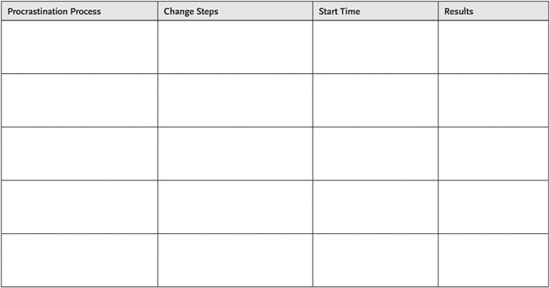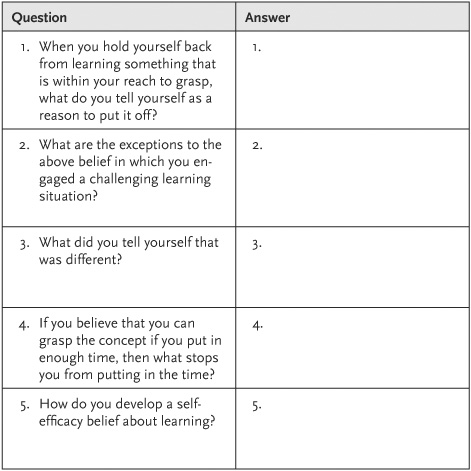Read End Procrastination Now! Online
Authors: William D. Knaus
End Procrastination Now! (21 page)

Harvard psychologist B. F. Skinner saw diversionsâinattention, daydreaming, and escape in the form of truancyâas responses to learning as aversive. He saw student escape and avoidance behaviors as emotionally charged with fear, anxiety, and anger.
You go through a long socialization process of learning to fit into your culture. This socialization process is necessary for an orderly society. However, it can have casualties, especially in the form of blame aversion procrastination.
You're an infant. You repeatedly hear sharp, emotionally toned corrective words like
no
. That
desist term
is directed toward correcting your behavior. If you heard the word
bad
, this is a
judgment term
that is directed at your character. Can early experiences that involve the internalization of negative words influence your perceptions and your willingness to learn? It depends on you, your perceptions, and the situations you may associate with learning adversities.
⢠Some judgment phrases may come across as forms of blame: “don't do that,” “you should know better,” “were you raised in a barn?” “how could you be so stupid?” “don't you ever listen?” A consistent barrage of judgment phrases can affect the way you act in certain learning situations. Behavioral diversion may be a solution for avoiding situations that you associate with defaming.
⢠A coercive “you should do this” or “you should do that” can grow out of early learning experiences. This coercive instruction may lead to compliant actions. However, depending on the situation and your perceptions, internalizing this coercion can lead to progressive malfunctioning in which you behaviorally divert from producing knowledge products.
⢠Judgment words and terms, such as “wrong” and “you shouldn't,” can lead, in some instances, to wariness and timidness when it comes to learning.
⢠You may be the target of rhetorical questions, such as “why aren't you getting this?” This type of rhetorical question is normally intended to belittle and control. You may be leery of learning in situations in which you are evaluated by a person who is bent on intimidating and controlling you.
⢠Aversions can come in the form of omissions. Let's suppose that as a student, you observed other students getting praise and benefits. You're not in this loop. You may have felt and acted as if you believed the answer to the rhetorical question “what's wrong with me?” That negative view can influence your motivation for learning.
When negative learning experiences, memories, and beliefs prompt learning procrastination, you have the option of breaking an aversive learning cycle or continuing on a path where learning is aversive.
Automatically holding back because of possible coercive criticism is self-limiting. A brief action exercise using self-regulatory questions to grease the skids for following through is on the next page:

Controlling the conditions for learning can lead to learning. If you view yourself as being in control, learning is likely to be less averse. Here are some behavioral suggestions that support self-regulated learning actions where you control key conditions. These same techniques, however, also apply to other forms of procrastination where it is useful to create a structure to get something that is a pressing priority done:
â¢
Positive associations
. Associate something pleasurable with learning. You may enjoy classical music. When you are involved in learning, have classical music playing in the background. If you like a candle-lit bath, have a learning tape playing in the background as you take your candle-lit bath.
â¢
Premack's (1965) principle.
Here's the idea. If you follow something that you normally prefer not to do with a preferred behavioral activity, you are reinforcing the less preferred behavior with the preferred behavior. For example, follow each ½-hour learning segment with something that you'd normally like to do. You may like viewing a five-minute Internet video segment updating you on your favorite sports team. You may prefer to stretch and run in place for five minutes, throw a ball for your pet, catch up on the news, or call a friendâanything you normally do that can reward a pressing and important learning process that you'd normally put off.
â¢
Intrinsic rewards.
You can give yourself your own intrinsic reward by verbally commenting “well done” for your learning and performance improvements.
â¢
Contingency contracts
. You write out a contract with yourself in which you give yourself a desired reward, such as treating yourself to a great meal at your favorite restaurant, for completing short-term objectives that are part of a longer-term goal. You penalize yourself for procrastinating by, say, writing a letter of praise to a politician you dislike or denying yourself your weekly night out at your favorite restaurant. You can benefit by finishing what you start, and that can be rewarding. You can gain a reward by avoiding a penalty (negative reinforcement). You gain the reward that you set for each phase of completion. However, the problem with contingency contracts lies in the enforcement of the penalty if you procrastinate on executing the contract.
Exposure training is the gold standard for overcoming fear. Procrastination impulses may track in parallel with brain anxiety and fear networks. This has yet to be assessed. Nevertheless, there is a psychological parallel between procrastination and anxiety and
fear. Procrastination, anxiety, and fear are characterized by escape and avoidance actions.
You can set procrastination exposure training into motion by:
1. Agreeing with yourself that you'll endure your initial discomfort-dodging urges without behaviorally diverting
2. Taking on a timely activity that you put off
3. Approaching the learning task with the idea that you are going to work through the tension to get to the desired result
4. Exposing yourself to the tension that you normally try to put off experiencing
5. Showing yourself that you don't need immediate relief from tension
6. Sticking with the feeling and showing yourself that you can tolerate tension
7. Using your higher mental resources to guide your actions
Procrastination exposure training is not a one-time event. Benefiting from this exercise requires many experiences in different contexts with different forms and degrees of procrastination. Eventually, you can train yourself to use task tension cues as triggers for engaging in purposeful activities and undergoing behavioral follow-through.
If you come to tolerateânot likeâthe tensions that you associate with performing, you have gotten past a major hurdle to a productive and high-quality life.
Psychologist John Goudy saw doing some disagreeable things as part of learning. He thought it was important to learn the importance of developing the habit of doing what is reasonable, whether the activity is unpleasant or not.
If you want a bigger reward and less long-term hassle, then grind out the work to get that result. Grinding takes toiling. Although
grinding it out does not guarantee happiness or accomplishment, the process can dramatically boost your chances for a purposeful life that is filled with meaning and worthy accomplishments.
Remember, you can override the urge to diverge by following a structured plan to build and maintain momentum in a productive direction. This approach is simple. The process is rarely that way. However, you are likely to have fewer short- and long-term complications if you replace behavioral diversions with self-regulated actions and the do-it-now way.
What three ideas have you had that you can use to help yourself deal with procrastination behaviors effectively? Write them down.
1.
2.
3.
What is your action plan? What are the three top actions that you can take to promote purposeful and productive outcomes? Write them down.
1.
2.
3.
What implementation actions did you take? Write them down.
1.
2.
3.
What things did you learn from applying the ideas and the action plan, and how can you next use this information? Write them down.
1.
2.
3.
Applying Techniques to Address Procrastination in the Workplace
The purpose of work is to accomplish something.
Work procrastination
includes putting off all or part of what you do to earn a living, and so you accomplish less.
Who engages in
work procrastination
? A percentage of those people who view their work as unpleasant and unfulfilling are likely to find ways to get around it: daydreaming, getting involved in office intrigues, going over the same ground, busywork, or withdrawal. However, while on the job, practically everyone will occasionally put something or another off. This includes people who are ordinarily conscientious, and in situations where procrastination can draw unwanted attention: “What happened to Charlie on this one? He dropped the ball.”
Organizations treat
time shrinkage
as a fact of life; some of them even build this factor into their pay scales. The basis for adjusting pay to take procrastination into account is simple: it's virtually impossible to eliminate daydreaming, personal calls, taking time to work up to getting started, slowing down, and so forth. If an organization can recapture some of the
time shrinkage
that it has discounted, that's a gain. However, some of the dollar costs from procrastination can be especially serious. Delayed callbacks may
result in lost business. Procrastination in adopting evidence-based personnel selection methods virtually guarantees selection problems that will inevitably come back to haunt the organization.
Most chief executives that I've spoken to about procrastination scratch their heads and tell me what currently bothers them about procrastination: a vice president who lives on the phone but doesn't have much to say; overdue performance reviews; talented outside salespeople who operate significantly below their capability; hand-wringing about introducing promising new products; energy expended in cover-your-tail activities and finger-pointing. However, a few believe that procrastination doesn't exist in their organizations. “We don't have procrastinators here (a 30,000-person organization). If we find them, we fire them.” Who can seriously believe that any organization is a procrastination-free zone? Not me.
Consistent forms of procrastination can have consistent consequences. Doug is excellent at estimating automobile collision damage. However, he procrastinates on getting paperwork and reports into file folders. Multiple times during the day, he pressures himself by looking for estimates among scattered piles and in odd places. Michelle excuses herself from sitting down with a subordinate and talking about his pattern of calling in sick or showing up late on Mondays. She tells herself that she needs more information. Jimmy is an excellent carpenter, and his prices are fair. However, he dislikes making estimates and negotiating prices, and so he loses opportunities by default.
Doug, Michelle, and Jimmy procrastinate in different work zones. However, because of regularities in their procrastination patterns, members of this group don't have to reinvent the wheel to deal with their special procrastination twist. You can find tested cognitive, emotive, and behavioral strategies for ditching procrastination, as found in this book. The technology is getting better.
Procrastination may not jump right out at you. The costs don't call attention to themselves. Some of your coworkers' greatest
source of enjoyment at work is connecting with one another about the latest office gossip, rumors, and criticism of the mistakes that others make. This discussion goes on in different ways throughout the day and often via the phone after work hours. Meanwhile, you're the
George
in “Let George do it.” Your work motivation slowly declines as you think it's unfair that the burden falls on you, but your pay is no different from that of the gossip group. You hold back on a great idea because you don't want to draw attention to yourself. This holdback procrastination is a career limiter.
